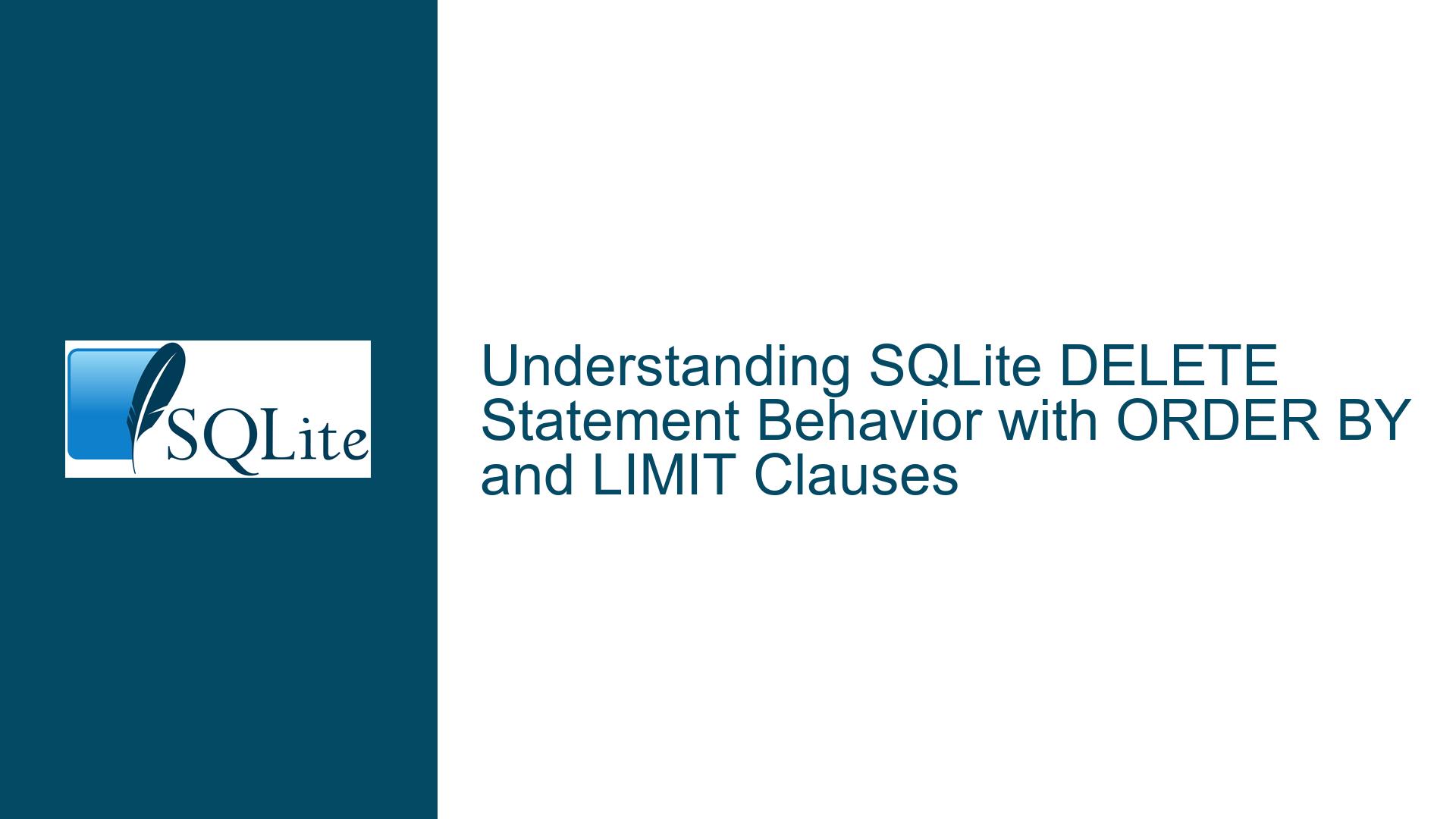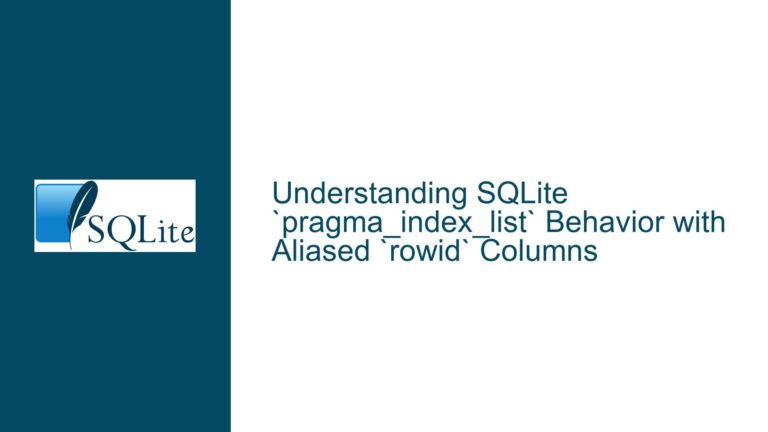SQLite DELETE Statement Behavior with ORDER BY and LIMIT Clauses
SQLite DELETE Statement: ORDER BY and LIMIT Clause Misinterpretation
The SQLite DELETE statement is a powerful tool for removing rows from a table, but its behavior when combined with ORDER BY and LIMIT clauses can be confusing. The confusion arises from the interpretation of how these clauses influence the deletion process. Specifically, the documentation states that the ORDER BY clause is used to determine which rows fall within the LIMIT, but the order in which rows are deleted is arbitrary and not influenced by the ORDER BY clause. This has led to misunderstandings about the actual behavior of the DELETE statement when these clauses are used.
The core issue revolves around the interpretation of the phrase: "The order in which rows are deleted is arbitrary and is not influenced by the ORDER BY clause." This sentence has been misinterpreted to mean that the ORDER BY clause has no effect on the selection of rows for deletion, which is not the case. The ORDER BY clause does indeed determine which rows are selected for deletion, but the actual order in which those rows are deleted is not guaranteed to follow the ORDER BY clause. This distinction is crucial for understanding how the DELETE statement operates in SQLite.
Misinterpretation of ORDER BY Clause in DELETE Statements
The confusion stems from the assumption that the ORDER BY clause in a DELETE statement controls the order in which rows are deleted, similar to how it controls the order of rows in a SELECT statement. However, this is not the case. The ORDER BY clause in a DELETE statement is used solely to determine which rows fall within the LIMIT clause. The actual deletion of those rows occurs in an arbitrary order, which is not influenced by the ORDER BY clause.
This behavior is particularly important when dealing with large datasets or when the order of deletion could have implications on the database’s integrity. For example, if a table has foreign key constraints or triggers that depend on the order of deletion, the arbitrary nature of the deletion process could lead to unexpected results. The documentation’s clarification that the ORDER BY clause does not influence the deletion order is meant to prevent developers from relying on the order of deletion for critical operations.
The misinterpretation of this behavior can lead to errors in application logic, especially when developers assume that the ORDER BY clause will enforce a specific deletion order. This assumption can be particularly problematic in scenarios where the order of deletion affects the outcome of subsequent operations, such as in cascading deletes or when dealing with hierarchical data structures.
Clarifying DELETE Statement Behavior and Best Practices
To avoid confusion and ensure that developers understand the behavior of the DELETE statement with ORDER BY and LIMIT clauses, it is essential to clarify the documentation and provide best practices for using these clauses effectively. The following steps outline how to troubleshoot and resolve issues related to the misinterpretation of the DELETE statement’s behavior:
Understanding the Role of ORDER BY in DELETE Statements: The ORDER BY clause in a DELETE statement is used to determine the order in which rows are selected for deletion, but it does not control the order in which those rows are actually deleted. This means that while the ORDER BY clause can be used to specify which rows should be deleted first based on a particular column or set of columns, the actual deletion process may not follow that order.
Impact of LIMIT Clause on Deletion: The LIMIT clause specifies the maximum number of rows that should be deleted. When combined with the ORDER BY clause, the LIMIT clause ensures that only the top N rows (based on the ORDER BY criteria) are selected for deletion. However, the order in which these rows are deleted is still arbitrary and not influenced by the ORDER BY clause.
Handling Arbitrary Deletion Order: Since the order of deletion is arbitrary, developers should avoid relying on the deletion order for critical operations. Instead, they should use transactions to ensure that the database remains in a consistent state regardless of the order in which rows are deleted. This is particularly important when dealing with foreign key constraints or triggers that depend on the order of deletion.
Using WHERE Clause for Precise Deletion: In cases where the order of deletion is important, developers should use the WHERE clause to precisely specify which rows should be deleted. This approach ensures that only the intended rows are removed, and the order of deletion is not a factor. For example, instead of using an ORDER BY clause to delete the first N rows, developers can use a WHERE clause with a condition that matches the desired rows.
Compile-Time Options for Extended DELETE Syntax: SQLite provides a compile-time option called SQLITE_ENABLE_UPDATE_DELETE_LIMIT, which extends the DELETE statement syntax to include ORDER BY and LIMIT clauses. Developers should ensure that this option is enabled if they need to use these clauses in their DELETE statements. Without this option, attempting to use ORDER BY and LIMIT clauses in a DELETE statement will result in a syntax error.
Testing and Validation: Developers should thoroughly test their DELETE statements to ensure that they behave as expected, especially when using ORDER BY and LIMIT clauses. This includes testing with different datasets and scenarios to validate that the correct rows are being deleted and that the database remains in a consistent state after the deletion.
Documentation Review and Updates: The SQLite documentation should be reviewed and updated to clarify the behavior of the DELETE statement with ORDER BY and LIMIT clauses. This includes providing examples and explanations that clearly differentiate between the selection of rows for deletion and the actual order of deletion. Additionally, the documentation should emphasize the importance of using transactions and the WHERE clause for precise deletion.
By following these steps, developers can avoid common pitfalls associated with the misinterpretation of the DELETE statement’s behavior and ensure that their database operations are both efficient and reliable. Understanding the nuances of how ORDER BY and LIMIT clauses interact with the DELETE statement is crucial for maintaining data integrity and achieving the desired outcomes in SQLite databases.






